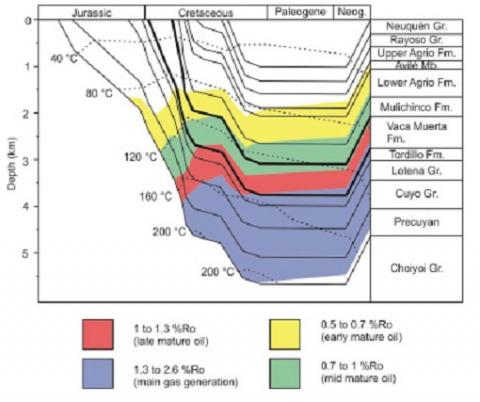Vincenzo Costanzo-Álvarez, Augusto E. Rapalini, Milagrosa Aldana, Marisel Díaz, Diego Kietzmann, María Paula Iglesia-Llanos, Ana Cabrera, Tomás Luppo, María D. Vallejo, Ana María Walther
2 019
Journal of Petroleum Science and Engineering, Volume 173, February 2019, Pages 861-879
A combined study of rock-magnetism and electronic-paramagnetic resonance (EPR) was performed in core samples from an oil well in the Vaca Muerta Formation (SW Argentina). The aim of this work was to characterize the effects of hydrocarbon-related diagenesis on the magnetic signature of oil shales. Similar research has been previously conducted in near-surface sediments affected by oil and gas microseepage, so as to establish a relationship between micromagnetic anomalies and the underlying reservoirs. The EPR technique was employed to measure minute concentrations of organic matter free radicals (OMFRs), Fe3+ and Mn2+. These results, and the concentrations of extractable organic matter (EOM), were compared with mass-specific magnetic susceptibility (χ) and natural remanent magnetization (NRM). The reactive OMFRs, resulting from the thermal degradation of a kerogen that yields a slightly-biodegraded crude oil, seem to have acted on the primary Fe oxides and sulfides through two diagenetic stages. The first stage might have partially dissolved these minerals. Consequently, a number of depth levels show a decrease of both χ and NRM, against an increase of the OMFRs. On the other hand, for a core-interval between 2663 and 2695 m (P18/P24), a second diagenetic stage could have produced partial replacement of framboidal pyrite by authigenic pyrrhotite, as recognized by scanning electron microscopy (SEM), electron X-ray energy dispersion (EDX) experiments and the analysis of the thermomagnetic and IRM curves. Thus, within P18/P24, magnetic parameters increase in direct proportion with the amount of OMFRs. The lithologies encompassed by P18/P24 show small levels of Mn2+, a proxy directly related to calcareous cementation. Moreover, Gamma Ray, resistivity and neutron porosity well logs reveal distinctive features for P18/P24, as well as an increase of hydrocarbon content, contrasting with the rest of the section analyzed. The hydrocarbon-induced magnetic anomalies in these oil shales seem to be conditioned mostly by their petrophysical properties.
https://www.sciencedirect.com/science/article/pii/S0920410518309495

